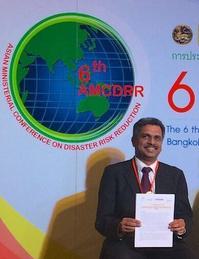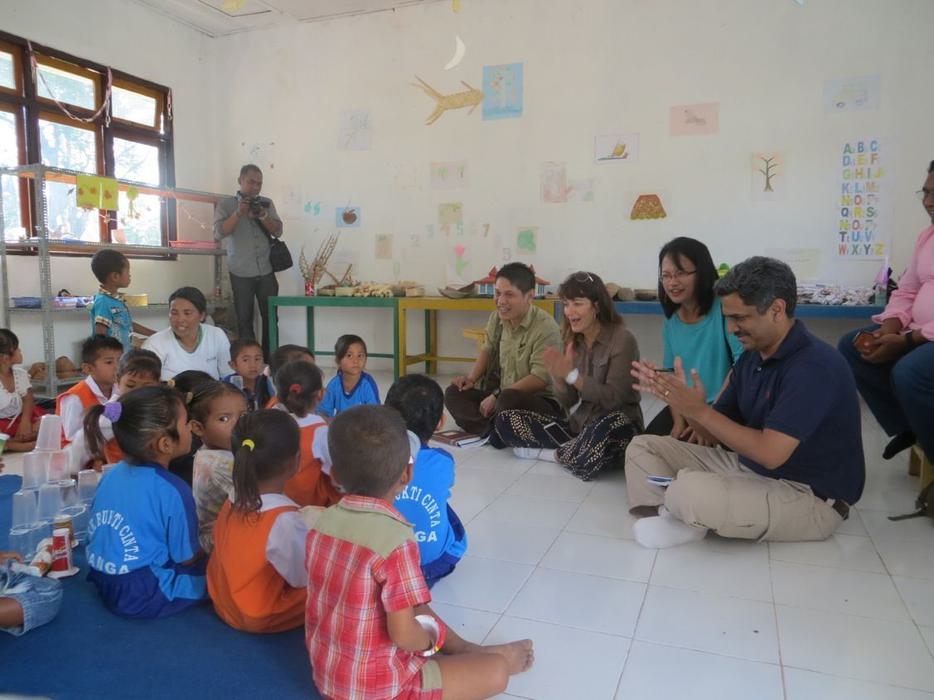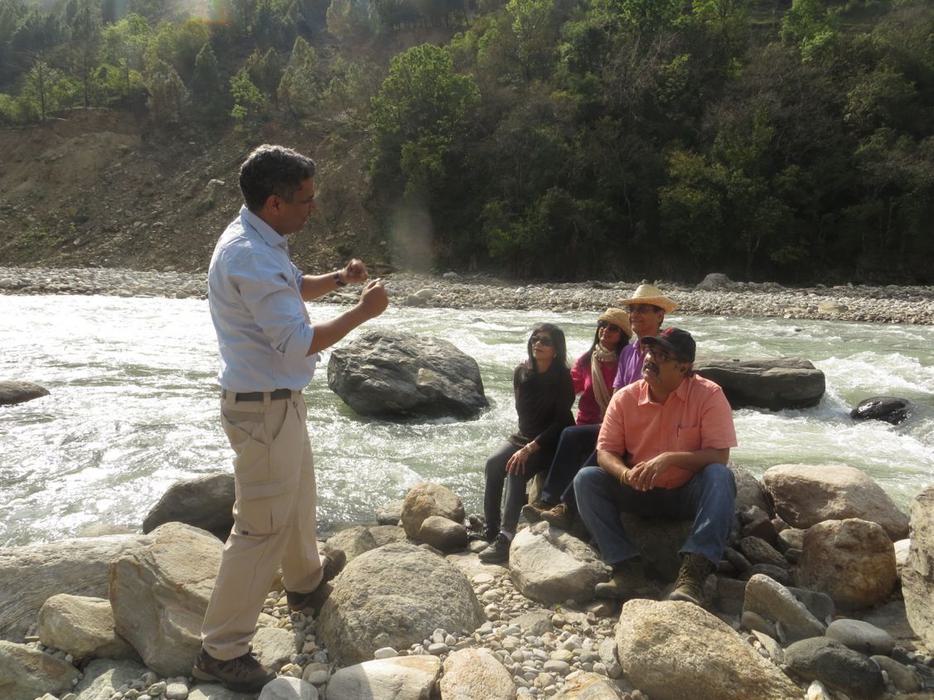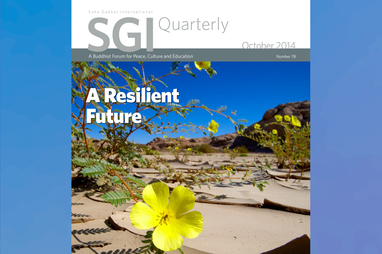SGI Quarterly

SGI member Manu Gupta is director of the Sustainable Environment Ecological Development Society (SEEDS) in New Delhi, India, and chairperson of the Asian Disaster Reduction & Response Network (ADRRN), a network of 53 national NGOs from 18 countries across the Asia-Pacific region.
SGI Quarterly: How did you become involved in this field initially, and what was your motivation for establishing the Sustainable Environment Ecological Development Society (SEEDS)?
Manu Gupta: At an early stage of my career, working on research and action projects with my professor in college brought me face to face with communities affected by natural disasters. Backpacking as volunteers with humanitarian organizations carrying out relief work in disaster-affected communities made my classmate and me realize our mission to devote our own skills (as planners and architects) to providing long-term solutions for communities that help improve the quality of their lives and protect them from harm in future disasters.
The original motivation of forming SEEDS found a clear purpose only after the devastating earthquake that struck Gujarat in western India in 2001. Together with a small team, I worked with a village of 250 families to reconstruct their houses through a unique participatory process.
SGIQ: What are the primary aspects of disaster risk reduction (DRR) that SEEDS aims to address?
MG: SEEDS aims to reach out to the most vulnerable sections of local society when building in DRR measures. Making education the central approach, we focus on enabling people to recognize risks in their environment, identify suitable actions to reduce these and mobilize resources for prevention and mitigation. Our most successful programs on DRR have been with schools and school-going children, where school safety plans, assessments, preparedness training and evacuation drills have been introduced in some of the most seismically active regions in the Himalayas. SEEDS is also working with community institutions in rural areas that are prone to recurrent disasters to create resilience through local food banks, stable supplies of drinking water and sustainable livelihoods.

With children at an early learning center in Indonesia
SGIQ: How do the initiatives led by SEEDS serve to enhance the resilience of the communities in which they are implemented?
MG: As an example, in a community in the western part of India, an arid region increasingly threatened by rain and flooding due to changing climate patterns, SEEDS worked with communities to improve their awareness of traditional house-building technologies that could insulate them against extreme heat and dust. Incorporating water-resistant features in traditional adobe architecture made them resistant to floods as well. Communities are now much more resilient to environmental changes without having to significantly alter their lifestyles. Part of the learning process involves getting the community together on common issues—to deliberate, reflect and identify solutions together. And when they see tangible results of their learning efforts, it brings them together. Indirectly, such social bonding to address a common problem contributes to building resilience.
SGIQ: What has SEEDS done to promote information sharing among communities?
MG: Timely, accurate and credible information can save lives. To the extent possible, SEEDS has relied on traditional sources of information among people and sought to improve them, adding custom-designed modules for knowledge sharing. In the southern coast of India, community-level village knowledge centers have been set up that provide short message service information on weather and sea-wave patterns to fishermen, cautioning them on any possible natural threats. In Myanmar and Pakistan, where access to the most vulnerable communities is limited by poor connectivity, mobile knowledge resource centers mounted on lorries and boats reach out to local communities, especially children, providing learning opportunities on DRR.

Discussing drinking water needs in Maharashtra, India [Photo credit: © SEEDS/Nupur Gupta]
SGIQ: What are the key factors that ensure the success of any given initiative?
MG: A critical factor in ensuring the success of any initiative is to not lose sight of its founding purpose. Taking up initiatives in disaster-vulnerable areas is not easy. From having to enable change in people’s perceptions to ensuring tangible results, the challenges are innumerable. To stay firm on one’s purpose and to be able to devote oneself to finding creative solutions for unprecedented challenges are what have ensured success in the past. Wading through such challenges, we have drawn on a larger team of individuals and partners to work for the common purpose. Developing genuine camaraderie with them through transparent leadership, mutual respect and shared purpose has contributed to scaling and replicating success.
SGIQ: What unique contributions can organizations rooted in civil society make to achieve successful implementation of DRR measures?
MG: Development, if made sustainable, should inherently incorporate DRR. However, this is often not the case, primarily due to lack of awareness, or because public authorities hold a limited view that ignores consideration of possible risks created through development investments. For civil society-based organizations, it therefore becomes their primary purpose to facilitate learning where there are gaps in achieving sustainable development outcomes and hold authorities to account in case they fail to act on their duty to protect people’s lives from disasters.
A critical factor in ensuring the success of any initiative is to not lose sight of its founding purpose.
SGIQ: In addition to your role as director of SEEDS, you are also the current chairperson of the Asian Disaster Reduction & Response Network (ADRRN). What is ADRRN?
MG: ADRRN was formed in 2002, bringing together national and local NGOs working on DRR and humanitarian response. The founding spirit was based on the felt need to build capacity and enhance the leadership role of southern-based NGOs in the region, which has been largely dominated by Western NGOs.
Currently, much of ADRRN’s work focuses on building members’ capacity through workshops and learning initiatives. By identifying local knowledge and promoting recognition of its value by the scientific community, the network seeks to create political space at regional and national levels to enable efficient dialogue and represent the voices and concerns of communities at risk.
ADRRN works closely with the UN. Most recently, following Typhoon Haiyan in the Philippines, ADRRN helped establish local NGO coordination centers for mapping out local needs and coordinating distribution of relief materials to areas where they were most needed. This experience presented a unique case wherein international, national and local humanitarian actors could work and coordinate among themselves.
Similarly, after the 2004 Indian Ocean tsunami, ADRRN facilitated learning exchange among its members and with prominent universities in the region. Trained construction worker experts on earthquake-resistant housing from Nepal could travel to train their counterparts in Aceh, Indonesia. Transcending all barriers of culture, language and religion, people-to-people learning at the cutting-edge level provided a good example of what such networks can achieve.
SGIQ: How does Buddhist philosophy influence your approach to your work?
MG: Buddhist philosophy has helped me recognize the fundamental dignity of life as the starting point of all endeavors. The work we undertake treats people as natural partners—be it for rebuilding after disasters or introducing an understanding of DRR. Mutual respect helps us learn and take action together. Each time I work in true partnership with people we are assisting in this way, I feel I have also gained a great deal from the work our organization has done with communities.
Each day when I start my work, I am filled with hope—a feeling that through my small actions, and joined by equally motivated colleagues in SEEDS, I can create the ripples of a much larger change in society.
Related Content


